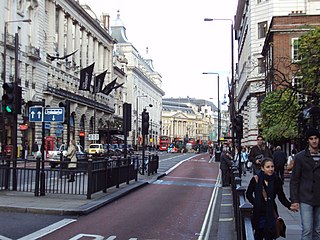
Piccadilly is a road in the City of Westminster, London, to the south of Mayfair, between Hyde Park Corner in the west and Piccadilly Circus in the east. It is part of the A4 road that connects central London to Hammersmith, Earl's Court, Heathrow Airport and the M4 motorway westward. St James's is to the south of the eastern section, while the western section is built up only on the northern side. Piccadilly is just under 1 mile (1.6 km) in length, and it is one of the widest and straightest streets in central London.

Pall Mall is a street in the St James's area of the City of Westminster, Central London. It connects St James's Street to Trafalgar Square and is a section of the regional A4 road. The street's name is derived from pall-mall, a ball game played there during the 17th century, which in turn is derived from the Italian pallamaglio, literally “ball-mallet”.

St James's is a central district in the City of Westminster, London, forming part of the West End. In the 17th century the area developed as a residential location for the British aristocracy, and around the 19th century was the focus of the development of gentlemen's clubs. Once part of the parish of St Martin in the Fields, much of it formed the parish of St James from 1685 to 1922. Since the Second World War the area has transitioned from residential to commercial use.
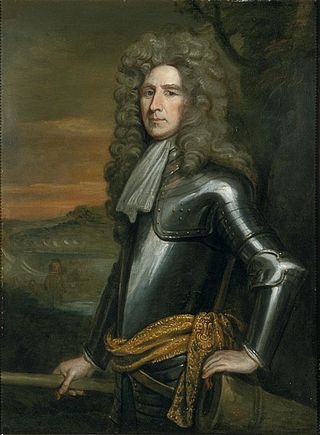
Henry Sidney, 1st Earl of Romney was an English Whig politician, soldier and administrator. He is now best remembered as one of the Immortal Seven who drafted the Invitation to William of Orange, which led to the November 1688 Glorious Revolution and subsequent deposition of James II of England.

Jermyn Street is a one-way street in the St James's area of the City of Westminster in London, England. It is to the south of, parallel, and adjacent to Piccadilly. Jermyn Street is known as a street for gentlemen's-clothing retailers.

The London Trocadero was an entertainment complex on Coventry Street, with a rear entrance in Shaftesbury Avenue, London. It was originally built in 1896 as a restaurant, which closed in 1965. In 1984, the complex reopened as an exhibition and entertainment space. It became known for the video-game oriented SegaWorld attractions which were added in 1996, and later downscaled and renamed to "Funland" before its closure in 2011. Part of the building was opened as a hotel in 2020.

Devonshire House in Piccadilly, was the London townhouse of the Dukes of Devonshire during the 18th and 19th centuries. Following a fire in 1733 it was rebuilt by William Cavendish, 3rd Duke of Devonshire, in the Palladian style, to designs by William Kent. Completed circa 1740, it stood empty after the First World War and was demolished in 1924.

St James's Street is the principal street in the district of St James's, central London. It runs from Piccadilly downhill to St James's Palace and Pall Mall. The main gatehouse of the Palace is at the southern end of the road; in the 17th century, Clarendon House faced down the street across Piccadilly from the site of what is now Albemarle Street.

Cambridge House is a Grade I listed former townhouse in central London, England. It sits on the northern side of Piccadilly at number 94, in the fashionable district of Mayfair. As of 2021, the property is being converted into a luxury hotel and seven residences.

Dover Street is a street in Mayfair, London. The street is notable for its Georgian architecture as well as the location of historic London clubs and hotels, which have been frequented by world leaders and historic figures in the arts. It also hosts a number of contemporary art galleries. An equestrian sculpture by Elisabeth Frink stands on the junction of Dover Street and Piccadilly, opposite the Ritz Hotel.

Albemarle Street is a street in Mayfair in central London, off Piccadilly. It has historic associations with Lord Byron, whose publisher John Murray was based here, and Oscar Wilde, a member of the Albemarle Club, where an insult he received led to his suing for libel and to his eventual imprisonment. It is also known for its art galleries and the Brown's Hotel is located at 33 Albemarle Street.

The Lanier Mansion is a historic house located at 601 West First Street in the Madison Historic District of Madison, Indiana. Built by wealthy banker James F. D. Lanier in 1844, the house was declared a State Memorial in 1926, and remains an important landmark in Madison to the present day. It was designated a National Historic Landmark in 1994 as one of the nation's finest examples of Greek Revival architecture.

Piccadilly Arcade runs between Piccadilly and Jermyn Street in central London. It was opened in 1909, having been designed by Thrale Jell, and is a Grade II listed building.

Westminster St James was a civil parish in the metropolitan area of London, England. The creation of the parish followed the building of the Church of St James, Piccadilly, in 1684. After several failed attempts, the parish was formed in 1685 from part of the ancient parish of St Martin in the Fields in the Liberty of Westminster and county of Middlesex. It included part of the West End of London, taking in sections of Soho, Mayfair and St James's. Civil parish administration was in the hands of a select vestry until the parish adopted the Vestries Act 1831. The vestry was reformed again in 1855 by the Metropolis Management Act. In 1889 the parish became part of the County of London and the vestry was abolished in 1900, replaced by Westminster City Council. The parish continued to have nominal existence until 1922.
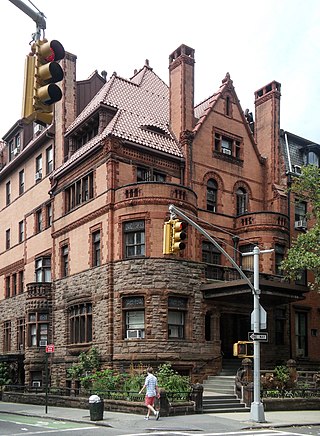
The Herman Behr Mansion is a building located at 82 Pierrepont Street at the corner of Henry Street in Brooklyn Heights, Brooklyn, New York City. Constructed in 1888–89 to a design of Brooklyn architect Frank Freeman, it has been described as "the city's finest Romanesque Revival house".
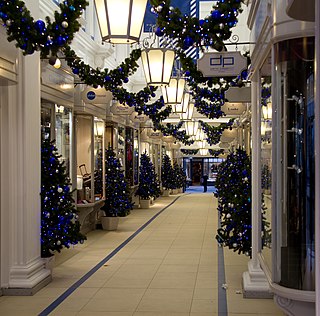
Princes Arcade is an arcade of shops running between Piccadilly and Jermyn Street in central London. It is home to a number of small menswear shops and boutiques.

The Cavendish Hotel is a modern 4-star, 230-bedroom, luxury hotel in St James's, London, United Kingdom, facing the restaurant front of Fortnum and Mason on Piccadilly. Across Piccadilly is Mayfair. It is currently known as "The Cavendish London" and it is owned by CapitaLand. Its main entrance is on Jermyn Street, and a side entrance is on Duke Street, St James's. Jermyn Street is an established retail and urban leisure street which has bespoke gentlemen's clothing stores, shoe/bootmakers and barber shops.

The Old White Horse Cellar also known as Hatchetts White Horse Cellar at No. 155 Piccadilly, was one of the best known coaching inns in England during the 18th and 19th centuries. The first mention of the White Horse Cellar is in 1720. It was originally located on the corner of Arlington Street, where the Ritz Hotel is now located. The first landlord, a man named Williams, named it in honor of the newly established House of Hanover, whose heraldic emblem featured a white horse. The White Horse rose to prominence under Abraham Hatchett who later moved it to the opposite side of the road on the corner of Albemarle Street, where it was known as "Hatchett’s Hotel and White Horse Cellar". The precise date of the move is not known, but was precipitated by the construction of the Bath Hotel, which was located on the corner of Piccadilly and Arlington as early as 1798. It was torn down in 1884 to make room for the Albemarle.
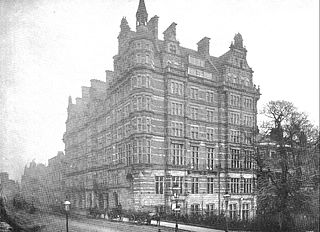
The Walsingham House or Walsingham House Hotel was located at 150-4 Piccadilly on the site of what is now The Ritz Hotel, London and was adjacent to the Bath Hotel. The Ritz's financial backers began negotiations in 1901 and purchased the Walsingham simultaneously with the Bath Hotel. Though the Walsingham was of fairly new construction, they determined it was too "inelegant" and demolished the building. One of the considerations that made the transaction appealing to the city was that they would be able to widen Piccadilly when the Walsingham and Bath Hotels were demolished.
Prince's Hall was a concert venue in Piccadilly, London.




















